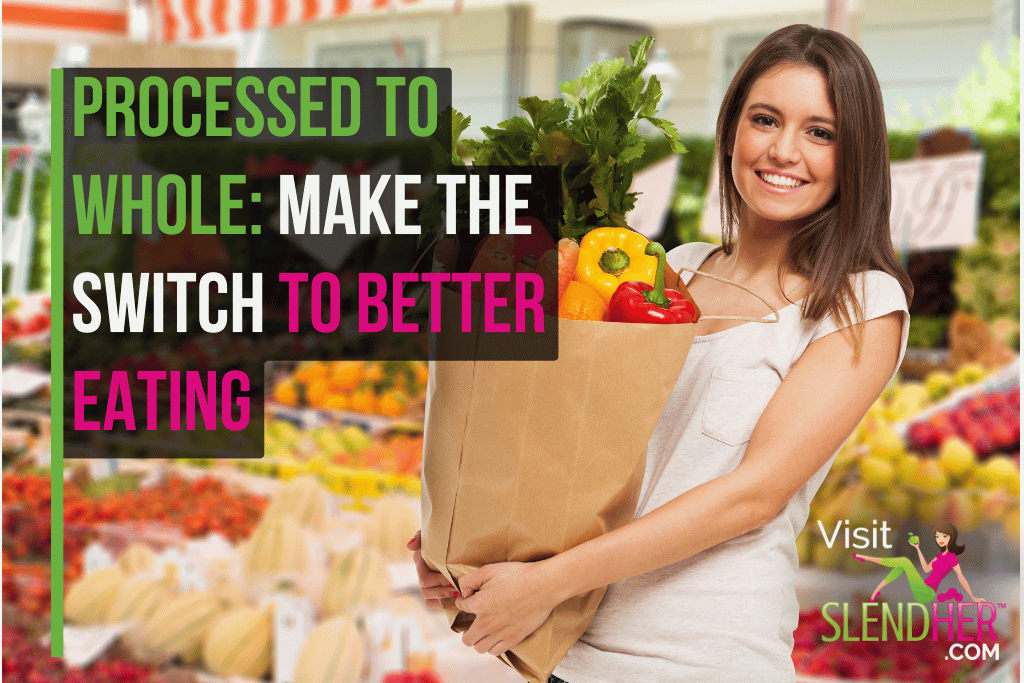
It’s a busy world out there, which means most people are in search of food that they can grab and go. But just because something may look, smell, taste, and make your mouth water like food, doesn’t mean it is in fact real food. Processed foods are all around you–the grocery store, at restaurants, and likely in your own kitchen. While processed may offer conveniences, it’s robbing your body of much-needed nutrients.

The best bet for a healthy meal plan, and one that will get your body in best fat burning shape, is whole foods–or food that is in it’s more natural form. Included in whole or real foods are fresh vegetables and fruits, unsweetened seeds, nuts, and dried fruits, fresh seafood and local meats, pasture-raised eggs, cheeses, and yogurts, and whole-grain products. While some foods will require some level of processing–after all, you’re probably not going to eat wheat straight from the husk–the idea is to stick to foods with limited, whole ingredients. Here’s how you can do so:
Avoid Aisles: While all grocery stores are laid out differently, the one thing they typically have in common is their location of fresh, whole foods. The outer perimeter is usually saved for fresh produce, whole dairy, bakery-fresh breads, and lean cuts of meats. The aisles, on the other hand, are where you’ll run into more foods laden with sugars, preservatives, and ingredients you can’t pronounce.
Redefine Fast Food: Since the popularity of processed foods relies heavily on convenience, you need to find whole foods that can be eaten on the go in order to make the switch a success. Handheld fruits, such as bananas, apples, pears, and grapes, are great packable snacks. Nuts, seeds, hard-boiled eggs, and sliced veggies have the same ease appeal. For a full meal, pre-roll lettuce wraps with lean meats, mustard, and avocado when you have no time to cook.
Become Label Literate: When buying foods that come in a package, be sure to read the labels. Ingredients are listed by what the item contains most first to least last. Stick to buying items that have as few ingredients listed as possible, making sure that you know what the ingredients are. If you can’t pronounce something, find another option.
Make It Yourself: With just a few kitchen tools, making your favorite foods in whole form fashion is actually quite quick. For example, if you love salsa and usually buy it in a jar, you can eliminate unnecessary sugars and preservatives by making it at home. With a food processor, you can easily mince jalapenos and cilantro, and add in quartered tomatoes, tomatillos, with a little salt and cumin for a whole food salsa in under five minutes. Ditch the chips and pair it up with fresh veggies for dipping instead. Dips, dressings, condiments, marinades, and seasonings are all easy and quick to whip up instead of buy processed.
Eat More Whole Foods: It may seem obvious, but if you want to eat less processed foods, fill up on more whole foods. Whole foods can be more filling, because of higher fiber contents, and thus eliminate the belly space for the processed stuff.
Friend a Farmer: Farmer’s markets and Community Shared Agriculture (CSAs), can be your best friend when making the whole foods transition. Foods from these sources are guaranteed local and fresh, and buying them helps support your local farming community. With farmer’s markets filled with veggies, fruits, local meats, dairy, and even whole sweeteners such as honey, you can skip the grocery store and still meet the needs of your meal plans.
Take It One Meal at a Time: If your eating more processed foods than whole foods, making the switch might feel overwhelming. Instead of trying to change everything at once, focus on changing one meal or snack session at a time. For example, if you eat cereal for breakfast, switch to an egg and veggie omelet or an unsweetened oatmeal made with naturally dried fruits and nuts. Break down your day by what you eat and find real food recipes that sound like tasty swaps.
Whole foods are a great way to get to whole health, and offer great taste without starving yourself of foods and tastes you love. What is your favorite whole food dish? Share it with others in the comments!

[…] a light snack or making a healthy meal of whole foods might give way to shoveling in handfuls of processed foods, or just eating too quickly in general. It may feel as though you’re satisfying the hunger, but […]